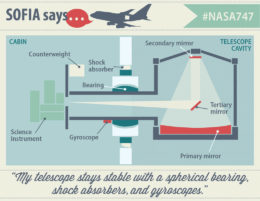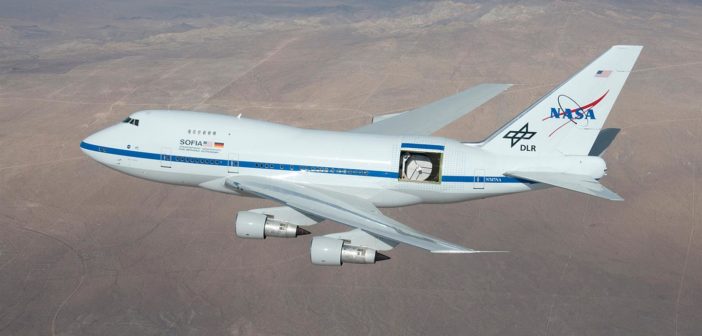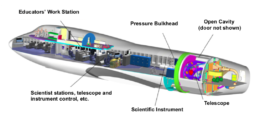In December, AAS Nova Editor Susanna Kohler had the opportunity to fly aboard the NASA/DLR Stratospheric Observatory for Infrared Astronomy (SOFIA) with the German Receiver for Astronomy at Terahertz Frequencies (GREAT) instrument. This week we’re taking a look at that flight, as well as some of the recent science the observatory produced and published in an ApJ Letters Focus Issue.
What’s more exciting than jetting through the stratosphere over the Pacific Ocean? Doing so with an opening the size of a garage door gaping in the side of your airplane — while observing the universe! Such is the bizarre experience of flying aboard the Stratospheric Observatory for Infrared Astronomy, or SOFIA.
Unusual Plane for an Unusual Payload
More than a year ago, I walked onto the tarmac at NASA’s Armstrong Flight Research Center in Palmdale, California, and caught my first glimpse of SOFIA. I was visiting to tour the observatory and its support facilities at the invitation of the SOFIA program.The Boeing 747SP gleamed in the sunlight, looking oddly stubby compared to its more familiar commercial-jetliner cousins. Of course, its short body is the least unusual thing about SOFIA; the giant, 18-by-13.5-foot door cut near the tail on its port side is unusual as well — not to mention the telescope pointed out of it.
NASA purchased the plane from United Airlines in 1997 and developed SOFIA as a joint project with the German Aerospace Center (DLR). The goal? To convert the plane into a flying infrared observatory vastly more capable than the venerable Kuiper Airborne Observatory (KAO) it was replacing.

Opacity of the Earth’s atmosphere to different wavelengths of light. SOFIA nominally observes from 0.3 µm to 1.6 mm, a window that is largely difficult to access with ground-based observatories due to the high atmospheric opacity. Click to enlarge. [NASA]
Challenge of Observing an Infrared Universe
Infrared light is a powerful tool for observing the universe. Not only do many objects shine in infrared — more than half of all starlight is emitted at infrared wavelengths! — but we can also use infrared light to probe environments obscured by gas and dust. Infrared astronomy teaches us about everything from stellar birth to celestial magnetic fields, newly forming solar systems, and even black holes lurking at the centers of galaxies.
Infrared observations are foiled by water vapor in Earth’s atmosphere, which is why most infrared telescopes are located in space. But once a telescope is in space, it’s difficult to make repairs or upgrades. SOFIA is a neat solution to this problem: the observatory is able to climb higher than 41,000 feet — above 99% of the Earth’s infrared-blocking atmosphere. After a night of taking data from the stratosphere, however, SOFIA returns to the ground, where it can receive repairs or upgrades as needed.

This view toward the rear of SOFIA’s pressurized cabin shows an instrument, HAWC+, mounted on the back of SOFIA’s telescope. SOFIA’s instruments can be swapped out many times each year to ensure a wide variety of observations. [NASA]
Engineering a Flying Telescope
As I boarded SOFIA, it was immediately obvious that the interior had been completely redesigned since the plane’s time with United. Instead of rows of cramped seats, SOFIA’s cabin contained workstations with computer monitors and communication ports. In places, the interior walls were missing the usual plastic facade, leaving the guts of the plane visible. Most prominent of all, the rear of the plane was sealed off by a solid bulkhead with complex machinery jutting through it.
SOFIA’s 2.7-m telescope mirror (three times the diameter of the KAO’s 0.9-m mirror) is just behind this wall in the depressurized rear of the plane, where it points out the open door during flight. The business end of the telescope assembly extends through the bulkhead and into the pressurized cabin; the chosen instrument for the current flight is mounted here, where the scientists in the cabin can access it.You’ve probably experienced for yourself the turbulence that comes from flying on an airplane. How is SOFIA able to make steady observations of sources mid-flight? As my guides, SOFIA team members Zaheer Ali and Jason Disbrow, walked me through the observatory, they explained some of the remarkable engineering involved.

SOFIA educational schematic detailing how the telescope is stabilized. [NASA/SOFIA/USRA/ASP/L. Proudfit]
Planning a Science Flight
After exploring SOFIA, I was escorted back through the hangar to the building that houses SOFIA’s roughly 80 onsite staff members — from software experts to aerospace engineers to scientists. The other half of SOFIA’s team is located at the SOFIA Program Office at NASA’s Ames Research Center about 350 miles to the north.
While meeting with members of SOFIA’s operational staff, I learned more about the complexities of operating a flying telescope. SOFIA’s altitude coordinate can be controlled by tilting the telescope up or down, but its azimuth coordinate is set by the direction the plane is flying. This necessitates intense in-flight coordination to successfully lock on to sources.

Map showing SOFIA’s 2017 flight paths. Though SOFIA is primarily based out of Palmdale, CA, the observatory also spends some time each year deployed to New Zealand to observe from the southern hemisphere. [NASA/SOFIA/Kassandra Bell]
An Opportunity to Fly
By the end of my tour, I was hooked on SOFIA’s story: a crazy idea with significant technical challenges had somehow been made into a successful reality. Now I desperately wanted to experience SOFIA during a science flight, to better understand how this was possible.
I was in luck. A year later, I was aboard SOFIA again — but this time, I was seeing the science in action.
Check back tomorrow to read the story of my flight!



3 Comments
Pingback: Observations of Betelgeuse’s Dimming from the Stratosphere
Pingback: Astrobites at AAS 236: Day 2 | astrobites
Pingback: Quart lieu web : Astrobites at AAS 236: Day 2 - Formation Création Site internet Web